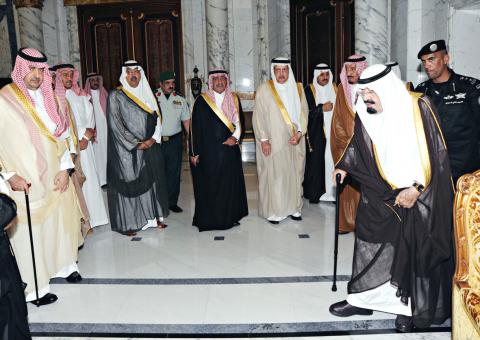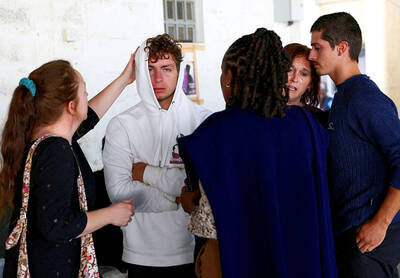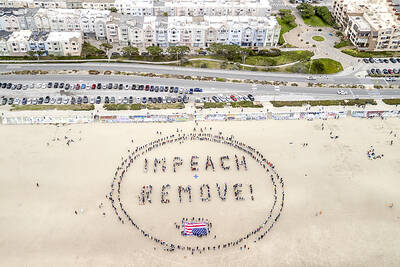Saudi Arabia was preparing yesterday to bury Saudi Crown Prince Nayef bin Abdulaziz Al Saud amid worldwide condolences, as Saudi Minister of Defense and Aviation Prince Salman bin Abdulaziz Al Saud appeared poised to become the new heir apparent.
An aircraft bearing the body of Nayef left Geneva early yesterday for the kingdom’s western city of Jeddah, Saudi-owned al-Arabiyah television reported.
The funeral of the Persian Gulf nation’s security czar was expected to take place later in the Muslim holy city of Mecca after sunset.

Photo: Reuters
He was to be buried in al-Adl cemetery near the Grand Mosque, where several members of the royal family and prominent Islamic scholars are interred, the Okaz daily said.
“Crown Prince Nayef devoted his life to promoting the security of Saudi Arabia,” said UN Secretary-General Ban Ki-moon, while US President Barack Obama praised his cooperation in the fight against terror that “saved countless American and Saudi lives.”
French President Francois Hollande said his country had lost a “friend” and the president of the Swiss Confederation, where Nayef died, offered Bern’s “deepest condolences.”
The 79-year-old prince died of “cardiac problems” while at his brother’s residence in Geneva, a medical source in the city who asked not to be identified said.
Nayef’s death, just eight months after he replaced his late brother, Sultan bin Abdulaziz Al Saud, as crown prince, raises the issue of succession because of the advanced age of the first line of apparent heirs, in a time of turmoil rocking the Arab world.
King Abdullah himself is 88 and ailing and nobody is officially in line to replace Nayef.
However, his brother, Salman, 76, who took the defense and aviation portfolio after Sultan’s death, appears to be a strong candidate.
“Prince Salman is the most likely successor,” Saudi political scientist Khaled al-Dakheel said.
“All expectations point to Prince Salman to succeed Prince Nayef for his experience in administration, security and politics,” agreed Anwar Eshqi, head of the Jeddah-based Middle East Center for Strategic Studies.
And Jane Kinninmont, a senior research fellow for the Middle East and North Africa at London’s Chatham House, said Salman is “generally assumed to be the next in line.”
In 2006, the Saudi monarch established the Allegiance Council, a body of about 35 senior princes, as a new succession mechanism whose long-term aim was to choose the crown prince.
Nayef was the middle prince of the Sudairi Seven, the formidable bloc of sons of late Saudi king Abdulaziz Al Saud by a favorite wife, Princess Hassa bint Ahmad al-Sudairi.
In addition to Salman, remaining Sudairis include Prince Abdul Rahman bin Abdulaziz Al Saud, Prince Turki II bin Abdulaziz Al Saud and Prince Ahmed bin Abdulaziz Al Saud, who is deputy interior minister and likely to succeed Nayef at the security helm.
Nayef, who spearheaded Saudi Arabia’s clampdown on al-Qaeda following a wave of attacks in the conservative kingdom between 2003 and 2006, became heir to the throne in October last year.
“He was one of the pillars of stability in the kingdom,” al-Jazirah daily wrote. “He managed to overcome crises and navigate this country to the shores of safety.”
Nayef traveled abroad several times this year for medical reasons, including to Algeria, the US and Switzerland, where he was shown on television in Geneva three days ago greeting supporters.
The nature of his illness was not made public.
Seen as more conservative than Abdullah, Nayef was a staunch defender of the Saudi dynasty and resisted any form of opposition.
He ordered and oversaw a fierce crackdown on al-Qaeda, forcing the jihadist group’s leaders and militants to flee to Yemen, from where they continue to be a thorn in the side of Saudi interests.

Young women standing idly around a park in Tokyo’s west suggest that a giant statue of Godzilla is not the only attraction for a record number of foreign tourists. Their faces lit by the cold glow of their phones, the women lining Okubo Park are evidence that sex tourism has developed as a dark flipside to the bustling Kabukicho nightlife district. Increasing numbers of foreign men are flocking to the area after seeing videos on social media. One of the women said that the area near Kabukicho, where Godzilla rumbles and belches smoke atop a cinema, has become a “real

Two Belgian teenagers on Tuesday were charged with wildlife piracy after they were found with thousands of ants packed in test tubes in what Kenyan authorities said was part of a trend in trafficking smaller and lesser-known species. Lornoy David and Seppe Lodewijckx, two 19-year-olds who were arrested on April 5 with 5,000 ants at a guest house, appeared distraught during their appearance before a magistrate in Nairobi and were comforted in the courtroom by relatives. They told the magistrate that they were collecting the ants for fun and did not know that it was illegal. In a separate criminal case, Kenyan Dennis

APPORTIONING BLAME: The US president said that there were ‘millions of people dead because of three people’ — Vladimir Putin, Joe Biden and Volodymyr Zelenskiy US President Donald Trump on Monday resumed his attempts to blame Ukrainian President Volodymyr Zelenskiy for Russia’s invasion, falsely accusing him of responsibility for “millions” of deaths. Trump — who had a blazing public row in the Oval Office with Zelenskiy six weeks ago — said the Ukranian shared the blame with Russian President Vladimir Putin, who ordered the February 2022 invasion, and then-US president Joe Biden. Trump told reporters that there were “millions of people dead because of three people.” “Let’s say Putin No. 1, but let’s say Biden, who had no idea what the hell he was doing, No. 2, and

DEMONSTRATIONS: A protester said although she would normally sit back and wait for the next election, she cannot do it this time, adding that ‘we’ve lost too much already’ Thousands of protesters rallied on Saturday in New York, Washington and other cities across the US for a second major round of demonstrations against US President Donald Trump and his hard-line policies. In New York, people gathered outside the city’s main library carrying signs targeting the US president with slogans such as: “No Kings in America” and “Resist Tyranny.” Many took aim at Trump’s deportations of undocumented migrants, chanting: “No ICE [Immigration and Customs Enforcement], no fear, immigrants are welcome here.” In Washington, protesters voiced concern that Trump was threatening long-respected constitutional norms, including the right to due process. The